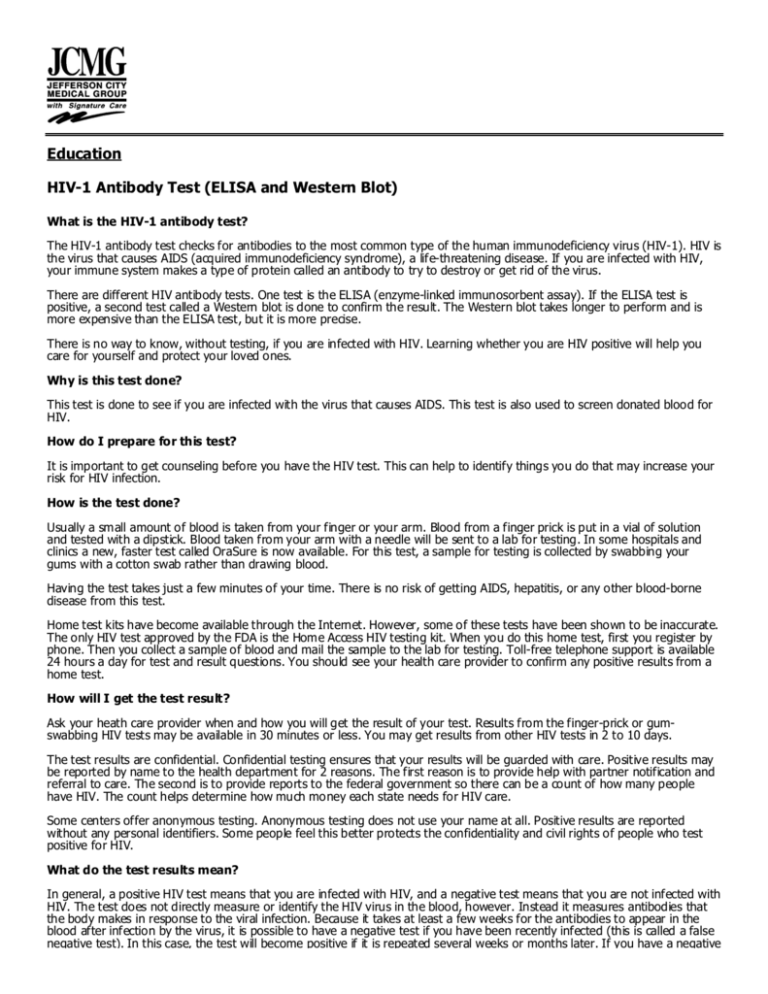
Education
HIV-1 Antibody Test (ELISA and Western Blot)
What is the HIV-1 antibody test?
The HIV-1 antibody test checks for antibodies to the most common type of the human immunodeficiency virus (HIV-1). HIV is
the virus that causes AIDS (acquired immunodeficiency syndrome), a life-threatening disease. If you are infected with HIV,
your immune system makes a type of protein called an antibody to try to destroy or get rid of the virus.
There are different HIV antibody tests. One test is the ELISA (enzyme-linked immunosorbent assay). If the ELISA test is
positive, a second test called a Western blot is done to confirm the result. The Western blot takes longer to perform and is
more expensive than the ELISA test, but it is more precise.
There is no way to know, without testing, if you are infected with HIV. Learning whether you are HIV positive will help you
care for yourself and protect your loved ones.
Why is this test done?
This test is done to see if you are infected with the virus that causes AIDS. This test is also used to screen donated blood for
HIV.
How do I prepare for this test?
It is important to get counseling before you have the HIV test. This can help to identify things you do that may increase your
risk for HIV infection.
How is the test done?
Usually a small amount of blood is taken from your finger or your arm. Blood from a finger prick is put in a vial of solution
and tested with a dipstick. Blood taken from your arm with a needle will be sent to a lab for testing. In some hospitals and
clinics a new, faster test called OraSure is now available. For this test, a sample for testing is collected by swabbing your
gums with a cotton swab rather than drawing blood.
Having the test takes just a few minutes of your time. There is no risk of getting AIDS, hepatitis, or any other blood-borne
disease from this test.
Home test kits have become available through the Internet. However, some of these tests have been shown to be inaccurate.
The only HIV test approved by the FDA is the Home Access HIV testing kit. When you do this home test, first you register by
phone. Then you collect a sample of blood and mail the sample to the lab for testing. Toll-free telephone support is available
24 hours a day for test and result questions. You should see your health care provider to confirm any positive results from a
home test.
How will I get the test result?
Ask your heath care provider when and how you will get the result of your test. Results from the finger-prick or gumswabbing HIV tests may be available in 30 minutes or less. You may get results from other HIV tests in 2 to 10 days.
The test results are confidential. Confidential testing ensures that your results will be guarded with care. Positive results may
be reported by name to the health department for 2 reasons. The first reason is to provide help with partner notification and
referral to care. The second is to provide reports to the federal government so there can be a count of how many people
have HIV. The count helps determine how much money each state needs for HIV care.
Some centers offer anonymous testing. Anonymous testing does not use your name at all. Positive results are reported
without any personal identifiers. Some people feel this better protects the confidentiality and civil rights of people who test
positive for HIV.
What do the test results mean?
In general, a positive HIV test means that you are infected with HIV, and a negative test means that you are not infected with
HIV. The test does not directly measure or identify the HIV virus in the blood, however. Instead it measures antibodies that
the body makes in response to the viral infection. Because it takes at least a few weeks for the antibodies to appear in the
blood after infection by the virus, it is possible to have a negative test if you have been recently infected (this is called a false
negative test). In this case, the test will become positive if it is repeated several weeks or months later. If you have a negative
test result but you are in a high-risk group, you may need to have another test in 3 to 6 months. Most people test positive 6
weeks after infection.
Although the HIV tests are very precise, sometimes the test result can be positive even though you do not have HIV infection
(this is called a false positive test). For this reason, when a positive result occurs, labs perform a second HIV test (Western
blot) to check the result.
What if my test result is positive?
If your first test for HIV is positive, you should have more blood tests to confirm the results. If repeat tests are positive, you
should seek medical care, even if you have no symptoms. In some cases you may need to start taking medicine to try to stop
the HIV infection from developing into AIDS. You need to discuss the test results with your health care provider or an HIV
counselor as soon as possible to protect your health and the health of people you love.
Adult Health Advisor 2006.4; Copyright © 2006 McKesson Corporation and/or one of its subsidiaries. All Rights Reserved.
Written by Jonathon Evans, MD. This content is reviewed periodically and is subject to change as new health information
becomes available. The information is intended to inform and educate and is not a replacement for medical evaluation,
advice, diagnosis or treatment by a healthcare professional.




